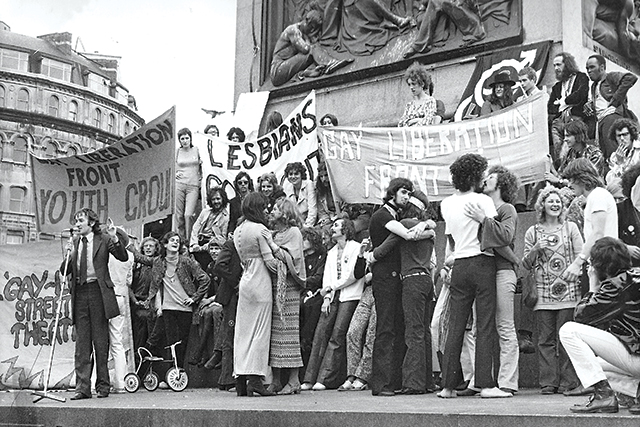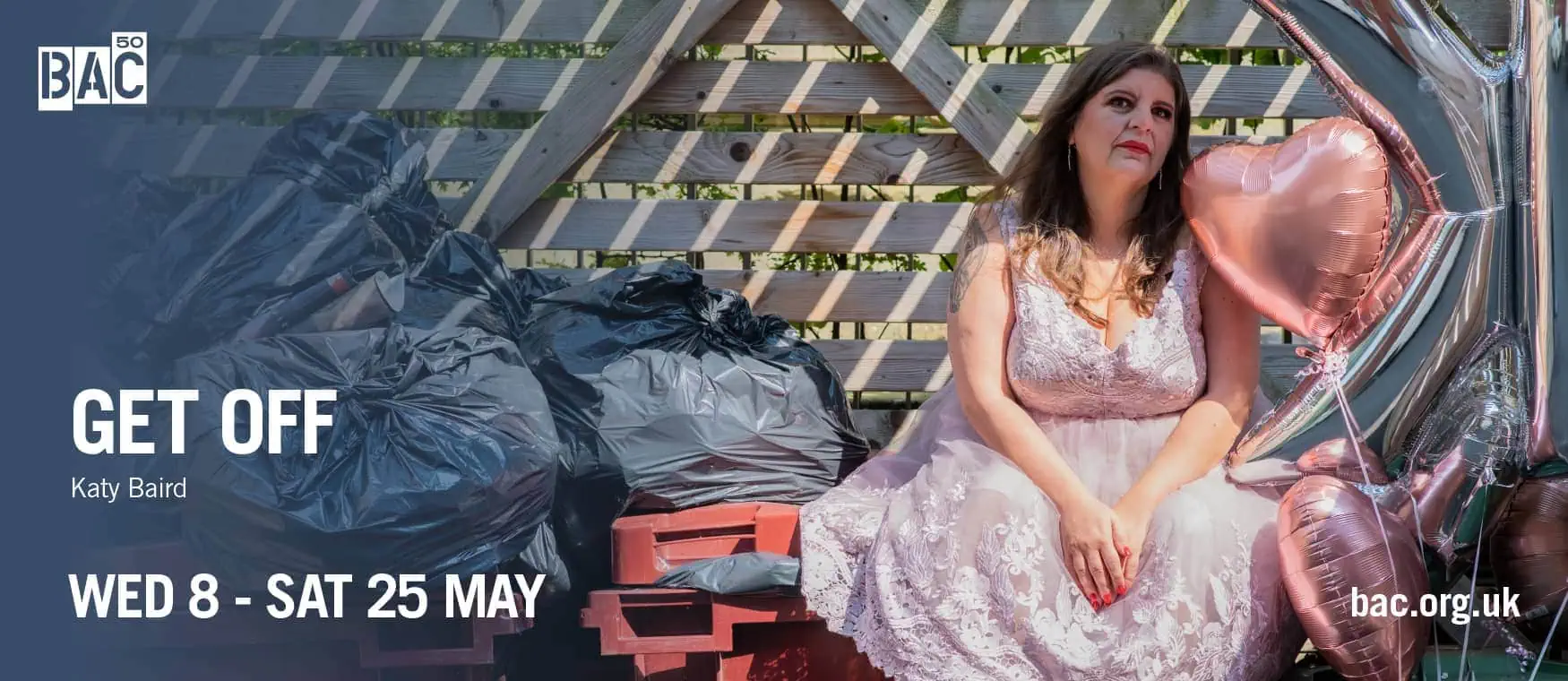Is the Gay Liberation Front, founded 40 years ago this month, “a watershed moment in queer history” or “the mad granny in the attic”? After meeting GLF veteran Alan Wakeman, David McGillivray reckons it’s a fabulous bit of both…
I’m told that ‘Come Together’, a celebration of the 40th anniversary of the Gay Liberation Front, held as part of Pride London last summer, wasn’t short of drama. All the GLF panellists (including Peter Tatchell), who’d previously agreed to participate, pulled out following a disagreement. Alan Wakeman stepped in as sole GLF spokesman, but wasn’t given a microphone and then began arguing with host Stewart Who? The conflict continued for much of the next two hours.
But we shouldn’t have expected anything else. The GLF, which began in New York in 1969 after the Stonewall riots and then spread around the world, existed for less than five chaotic years and collapsed in turmoil. Lisa Power, who now works for the Terrence Higgins Trust, tried to write its history. But it wasn’t easy. Hardly any records had been kept. She says that, to many of today’s LGBT activists, the GLF is “the mad granny in the attic.” But Peter Tatchell, writing in QX, called the GLF “a watershed moment in queer history.” It’s easy to see his point too. He was one of the first generation of gay men and lesbians who didn’t plead for tolerance, but demanded equality. They taught us to replace the self-hatred we associate with Quentin Crisp and his clan with pride. It may have been disorganised, but the GLF envisioned a simple concept that has united us and driven every LGBT liberation movement throughout the world ever since.
Aubrey Walters and Bob Mellors saw what was happening in the US in the late 1960s and founded the first British chapter of the GLF at the London School of Economics on 13th October, 1970. Weeks later it was discovered by Alan Wakeman, a former architect who’d dropped out in 1959 to live in Paris but then returned to the UK to teach English. Now 74, Wakeman looks like (and indeed is) a mischievous old hippy and lives in a stylish Soho flat he designed himself. Over a vegan meal (he co-wrote The Vegan Cookbook in 1986), he travelled back in time to 1970. “There was a teachers’ room at the school where I taught,” he recalled, “and I overheard one of the teachers in high dudgeon about the fact that that these appalling homosexual perverts were holding meetings in an arts centre in Covent Garden! And I thought, ’Where?’ I found out and went to the next meeting.
“The critical thing to say is that the GLF was not an organisation, it was a movement, a transformation of society.”
“The reason the GLF meant so much to me was that I could never understand the gay scene. It seemed to be based on getting drunk or having anonymous sex, neither of which was of any interest to me at all. I’m afraid I wanted love, the whole damn works, but that didn’t seem to be available anywhere. I certainly wasn’t going to go through some secret door where you had to knock three times and ask for somebody. I was young then and, although I didn’t know it at the time, quite good looking. So when I did go into gay places – and I did occasionally when I was invited by people – I was acutely uncomfortable about being sized up. It all felt wrong until GLF happened and that suddenly felt right.
“Part of me felt I’d been waiting all my life for this. Someone was deputed to talk to the people who’d come for the first time and his name was Stuart Feather [now an artist noted for male nudes] and we went off and sat down. He talked about how we thought there was something wrong with us but that there wasn’t. I can remember being incredibly admiring of him for his poise and his self-acceptance. I thought I could never be like that. But within two weeks I was doing it myself!”
By this time the GLF had outgrown its Covent Garden basement and moved to the church hall of All Saints in Powis Square, Notting Hill. “For nearly all of us it was a unique experience, the first time in your life you’d been in a room with hundreds of gay people like you.” One of Wakeman’s first ideas was to hold a Christmas party for deprived children in the area. Monty Python’s Graham Chapman was among those who contributed.
The party was a big success but hard to arrange. “I can remember being very frustrated at the meetings because the whole of GLF philosophy was that no one’s in charge. So you all just pitched in what you felt like saying. But to make a party happen requires someone to be in charge. I was used to running departments at my school and this was my first confrontation with anarchy. As Joyce Grenfell once said,’ Anarchy is all very well, but who will clean the drains?’”
Anarchy ruled throughout Wakeman’s time with the GLF. “The critical thing to say is that the GLF was not an organisation, it was a movement, a transformation of society. It had a kind of organic structure. People who wanted to do street theatre formed a group and then did street theatre. But it didn’t really work as a whole. Whenever you tried to organise an event half the people didn’t turn up, the people who did turn up didn’t know why they were there. It was complete chaos but it was fun.”
The chaos that led to the disintegration of the GLF was caused by rival factions. “I think Aubrey Walters and [his partner] David Fernbach were very political, they were radical left wingers and what they wanted was a revolution. I thought, ‘Sorry, I’m not sure about a revolution.’ The thing about revolutions is that you end up back where you started. That’s the meaning of the word. You just have to read Animal Farm to know where that leads.” Only a month after the GLF Manifesto was published in October, 1971, the first splinter group formed. Then, in January 1972, the women walked out en masse, never to return. “I’d always noticed that the meetings were predominantly male. I’d say three quarters were men. The women made useful, valid points but, when they spoke, the men were very patronising. I’d heard women say, ‘The men don’t listen to us.’ But I didn’t realise they were getting so het up. Then one night they staged a coup and went off to form their own group. Many men were very upset and said, ‘Please don’t leave.’ We voted to give all the GLF funds to the women. But did we get any thanks? No, we didn’t. They became completely separate and they wouldn’t speak to us. But I’m not really angry any more.”
This split marked the beginning of the end and, although splinter groups survived for longer, the London GLF ceased to exist after 1973. Forty years on, Wakeman may not be angry, but resentment still exists. Walters and Fernbach, who now live in France, refuse to take any part in this year’s celebrations. “After GLF broke up into its constituent parts,” says Wakeman, “they were involved in a publishing business [Gay Men’s Press] which a lot of people thought was making a mint. In fact it was loss-making. They got into trouble and they were unhappy that they got no help or support from anyone. I think that has left a degree of bitterness. But I don’t know. I can’t speak for them.”
Other organisations that grew out of the GLF include the London Lesbian & Gay Switchboard, Gay News, London Friend and indirectly Stonewall and OutRage! Peter Tatchell and other OutRage! members have utilised protest tactics pioneered by the GLF. The stunts that the press particularly loved were the so-called “zaps” in which GLF members would infiltrate meetings of homophobes and then, at a given signal, grab microphones and cause general disruption. The most famous incident occurred when demonstrators released mice at the inaugural rally of moral reformer Mary Whitehouse’s Festival of Light. But there were many others. “Good fun, but scary,” is how Wakeman sums them up. Most significantly, however, the GLF instigated the marches that developed into the annual festival that is now Pride. Wakeman took part in the first in 1971.
“We met at Marble Arch and we marched along Oxford Street and down Regent Street to Trafalgar Square. About 1,000 people turned up. It was the first time I’d seen 1,000 homosexuals and it was a mind boggling experience for that reason. I was apprehensive the day before. I thought people were going to throw stones at us. And then on the march I was observing everybody and I realised that the average person was simply not interested. I went up to every man in the street that I fancied and said, ‘Can I kiss you?’ And not one of them said no! So I kissed about 30 or 40 beautiful men in one day.”
Such daring could have got Wakeman arrested only four years earlier. In the years that have since passed gay men and lesbians can not only kiss in the street, they can be civilly partnered. “Gay marriage” was so inconceivable in 1971 that it wasn’t even included in the demands of the GLF manifesto. The eight demands that were made have all been met, at least in part. “I thought that some of the demands were unrealistic,” Wakeman admits. “The idea that you could ever get legal equality seemed impossible. I think it’s remarkable how much we’ve achieved. Look how long it took women to get the vote. It’s amazing.”
Wakeman realises that, despite our victories, the fight that the GLF began will never end. “In each generation ignorance is reborn anew,” he says. “So unfortunately every generation has to do its own coming out. Schools today are no different from when I was at school. I find that so distressing.” (Wakeman wrote a play, Where the Heart Is, on the subject of homophobia in schools. It was performed at the Drill Hall in 1996).
He’s also angered by prejudice in gay society. He tells a story about going with a friend his own age to a popular Soho bar. Five lads seemed to resent their presence. Wakeman found himself going up to them and telling them that “this place wouldn’t be here if not for people like me!” He says he terrorised them and they left. “I’m still feisty,” he tells me with a laugh. “But I’m now a member of the Old Liberation Front!”
Firebrands in Frocks: The Radical Drag Queens of The Gay Liberation Front













